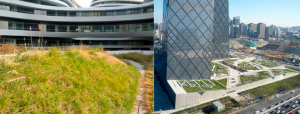The hype over urban farming is spreading. International media continue to clamour over the latest rooftop and trendy vertical farming projects in Beijing, London, New York and other cities around the world.
For cities like London, city farming represents something of a return to former times. In the 1940s, during the Second World War, the central Hyde Park was given over to growing vegetables.
In Beijing, meanwhile, it is peri-urban farming, outside the outer ring-road, that has been seen to offer the best opportunity for food production within the city limits.
What the latest soil-free and rooftop farming technologies present is an opportunity not only to return a level of personal or household food production to cities, but also create a viable commercial urban farming sector.
While no-one is predicting vast swaths of urban space being given over to productive agriculture – there simply isn’t enough room in densely populated cities like Beijing or Singapore – there are a growing number of examples out there pointing to a growth of urban-based agriculture over the next decade.
It just may not be the agriculture we know.
Growing food without soil
The densely populated state of Singapore has been desperately trying to increase in size since the 1960s by reclaiming land from the sea. Even with plans to expand its surface area by 7% by 2020, it is still severely land scarce.
With little spare land for agriculture, unsurprisingly, it is heavily dependent on imports, with more than 90% of its food, including six key commodities – chicken, pork, fish, eggs, rice and vegetables imported.
Enter aeroponics, which presents an opportunity to grow food in a limited amount of space. Under this farming system, plants are cultivated with their root systems suspended in the air while a nutrient solution, circulated in mist form, maintains a constant film of nutrients and moisture on the roots.
One of the world’s largest aeroponic farms has been running for more than a decade in Singapore, producing cut and bagged salads and herbs for local supermarkets – perishable products that are difficult to import.
According to local urban farming expert He Jie, professor at Nanyang Technological University in Singapore, the ability to grow vegetables without soil makes aeroponics well-suited to a dense, urban setting.
“While it isn’t possible for arable land to be expanded horizontally, an urban farming system could increase production area through vertical extensions of lightweight troughs,” she explains. “Vertical stacking is constrained by the weight of the troughs, but this could be resolved through the more lightweight aeroponic system, where stacking of lightweight troughs can offer an alternative to overcome the weight factor.”
Closed loop farming
In London, it’s a water-based system of farming known as aquaponics that is slowly gaining ground. The opening of FARM, a café and urban farm in east London back in 2010 set the ball rolling, showcasing how a tank of fish could be used to cultivate vegetables for salads.
The waste from two large tanks of tilapia fish in the cafe, fertilises vertical stacks of lettuce and other vegetables.
The company behind this installation, Aquaponics UK, has said it is getting three or four orders a month to install the system.
Twenty-something entrepreneur Kate Hofman is one of those trying to drive on the use of aquaponics. A sustainability graduate, she has recently set up a company, Grow Up, to supply and set-up aquaponic sites and is setting up a demonstration site in Bermondsey, close to central London, this summer.
To help get her project started, Kate linked up with Swiss-based Urban Farmers, a company which pioneered aquaponics in Switzerland and installed the first rooftop farm in the city of Basel.
While high-tech solutions like aquaponics and aeroponics are fascinating to document, there is also a larger but, perhaps, less glamorous urban farming sector based on more traditional techniques.
Adrienne runs Cultivate London, a social enterprise, which is farming across three sites in West London. Most of the sites are on temporary lease, typically on derelict land owned by property developers.
Operated by a team of volunteers and experienced gardeners, Adrienne expects the three sites to be able to produce 40,000 kilograms of fresh cut salads this year – a miniscule amount in the context of London’s overall food needs, but a successful demonstration of what kind of produce urban farming is likely to expand around. The three sites also produce potted flowers, herbs and vegetables, but it is the salads, chopped and bagged, that have proven the most popular and profitable product.
“I don’t think we can grow all the food London needs, but we could certainly grow all of London’s salads,” says Adrienne. “It wouldn’t require much space and it’s a high-value product that we’re currently importing from Italy and Spain, so it would make sense to grow here, if we could.”
Adrienne says being peripatetic, as well as creative with the spaces available, are both critical for aspiring urban farming enterprises. Perhaps even more necessary in Asian cities like Beijing and Hong Kong, where available derelict land seems scarcer than Europe or the US.
Urban farming goes corporate
In Beijing, recent estimates, published in chinadialogue, suggested the city has around 90 million square metres of empty rooftop space, some of which could be used for growing food.
Its harsh climate may deter many people, but early pioneers like Zhang Guichun, who has proudly shown off his 15-kilogram marrow and homemade dumplings to television crews from CCTV, have achieved celebrity status for their rooftop farms.
There are more commercial examples in Hong Kong, where Osbert Lam, owner of City Farm in Hong Kong, runs a rooftop business hiring out small garden plots to locals to grow their own fruit and vegetables. He says he was forced into a rooftop farming location because of extortionate ground rents in the city and now has 400 growing boxes on the 10,000-square-foot (930-square-metre) rooftop, available to rent for between HK$150-200 ($20-25) a month each.
The most developed commercial urban farming sector is probably in the US, where in cities like New York urban farming is already switching from a trendy activity to a corporate success story.
The Brooklyn organic rooftop farm is a 6,000 square metre farm on top of a warehouse rooftop, with views across to Manhattan island and the Empire State Building. Opened in 2009, it now supplies local restaurants, as well as selling produce through a weekly farm market.
The farm was designed and built by a company called Goode Green, which has a number of other successful rooftop farms including a vegetable farm on top of a hotel.

Jack Astbury runs a rooftop farming business on top of a supermarket in London, supplying it with fresh salad (Image by Tom Levitt)
Another company, BrightFarms, has recently struck a deal to build what it claims will be the US’s largest rooftop greenhouse in Brooklyn, producing enough vegetables to feed 5,000 people.
It says the project will help cut out the transport costs of importing produce into New York from the major vegetable-growing regions in California and the west coast of the US, as well as producing fresher crops. However, the heating costs of the greenhouse during the cold New York winters could outweigh any potential environmental savings.
In the past week, the world’s largest indoor vertical farm opened in a suburb of Chicago, making use of an abandoned warehouse site to grow fresh basil and salads.
Salads, greens and high-value foods
A trend shared by the more profitable urban farms emerging in the US, as well as Europe and Asia, is the focus on growing high value, perishable crops like herbs and salads.
“If you did the maths you’d just grow salads and not even herbs,” says Jack Astbury, the head grower at Food from the Sky, which has taken over the rooftop above a supermarket store in London. “With salads we can show how fresh it is, nothing else does as well,” he explains.
In a unique partnership, food produced on the roof, with the help of volunteers, is sold the same day it is picked downstairs in the supermarket. The fresh salads are usually sold out by early afternoon, with a stream of loyal customers.
It is very much a shoestring business, with a Jack running the whole project on a part-time basis. Sales of £7,500 enabled him to work one day a week in 2012. He is aiming to push that up to £11,000 this year to cover the farm’s running costs and his wages for two days a week, although a cold start to the year has already put production behind schedule.
By restricting yourself to leafy green vegetables, Jack believes urban farming can be profitable.
“It is possible [to make a commercial urban farming business] because your customer and buyer are so close and all around you in a city,” says Jack. “The money is there to be made if you can attract the people. But I think the future is in intensive solutions that can maximise the yield in small spaces, because it’s really hard to make money when food is so cheap and city space is so expensive.”
A future of intensive and specialised urban farming models, based on soil-free hydroponic/aquaponic systems, is one that has already been predicted in a report from 2011 by Kubi Ackerman, from Columbia University’s Earth Institute.
But Ackerman also points to three other important roles; utilising neglected space, educating the public on food and benefiting deprived neighbourhoods with low consumption of healthy foods. All of which could yet entice state and city governments to support a second, less commercial, urban farming sector.


